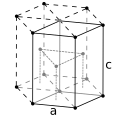< Template:Infobox lutetium Revision as of 19:48, 22 May 2019 by imported>Jonesey95
[[Category:Template:Pagetype with short description]]
Lutetium, 71 Lutetium Pronunciation (Template:Respell ) Appearance silvery white Standard atomic weight A r, std (Lu) Template:Val [1] Lutetium in the periodic table
Atomic number (Z ) 71 Group group 3 Period period 6 Block d-block Element categories , sometimes considered a transition metal Electron configuration [Xe ] 4f14 5d1 6s2 Electrons per shell 2, 8, 18, 32, 9, 2 Physical properties Phase at STP solid Melting point 1925 K (1652 °C, 3006 °F) Boiling point 3675 K (3402 °C, 6156 °F) Density (near r.t. ) 9.841 g/cm3 when liquid (at m.p. ) 9.3 g/cm3 Heat of fusion ca. 22 kJ/mol Heat of vaporization 414 kJ/mol Molar heat capacity 26.86 J/(mol·K) Vapor pressure
P (Pa)
1
10
100
1 k
10 k
100 k
at T (K)
1906
2103
2346
(2653)
(3072)
(3663)
Atomic properties Oxidation states 0,[2] +3 basic oxide) Electronegativity Pauling scale: 1.27 Ionization energies 1st: 523.5 kJ/mol 2nd: 1340 kJ/mol 3rd: 2022.3 kJ/mol Atomic radius empirical: 174 pm Covalent radius 187±8 pm Spectral lines of lutetiumOther properties Natural occurrence primordial Crystal structure hexagonal close-packed (hcp) Thermal expansion poly: 9.9 µm/(m·K) (at r.t. ) Thermal conductivity 16.4 W/(m·K) Electrical resistivity poly: 582 nΩ·m (at r.t. ) Magnetic ordering paramagnetic [3] Young's modulus 68.6 GPa Shear modulus 27.2 GPa Bulk modulus 47.6 GPa Poisson ratio 0.261 Vickers hardness 755–1160 MPa Brinell hardness 890–1300 MPa CAS Number 7439-94-3 History Naming after Lutetia Discovery Carl Auer von Welsbach and Georges Urbain (1906) First isolation Carl Auer von Welsbach (1906) Named by Georges Urbain (1906) Main isotopes of lutetium
Category: Lutetium references
References These references will appear in the article, but this list appears only on this page.
↑ Meija, Juris; et al. (2016). "Atomic weights of the elements 2013 (IUPAC Technical Report)" . Pure and Applied Chemistry 88 (3): 265–91. doi :10.1515/pac-2015-0305 ↑ Yttrium and all lanthanides except Ce and Pm have been observed in the oxidation state 0 in bis(1,3,5-tri-t-butylbenzene) complexes, see Cloke, F. Geoffrey N. (1993). "Zero Oxidation State Compounds of Scandium, Yttrium, and the Lanthanides". Chem. Soc. Rev . 22 : 17–24. doi :10.1039/CS9932200017 . Arnold, Polly L.; Petrukhina, Marina A.; Bochenkov, Vladimir E.; Shabatina, Tatyana I.; Zagorskii, Vyacheslav V.; Cloke (2003-12-15). "Arene complexation of Sm, Eu, Tm and Yb atoms: a variable temperature spectroscopic investigation". Journal of Organometallic Chemistry . 688 (1–2): 49–55. doi :10.1016/j.jorganchem.2003.08.028 .
↑ Lide, D. R., ed. (2005). "Magnetic susceptibility of the elements and inorganic compounds". CRC Handbook of Chemistry and Physics (PDF) (86th ed.). Boca Raton (FL): CRC Press. ISBN 0-8493-0486-5 Lua error: Internal error: The interpreter has terminated with signal "24".


